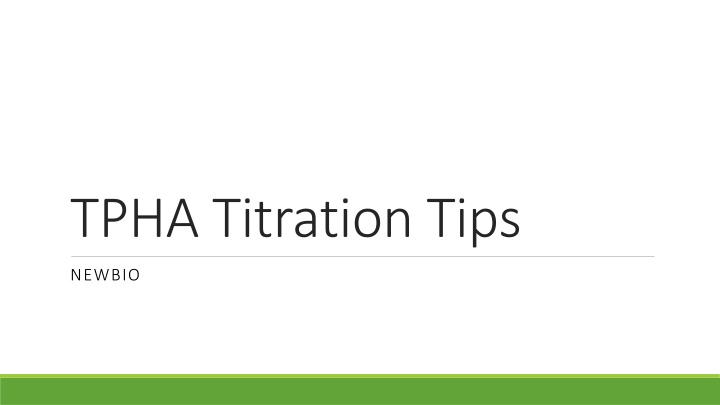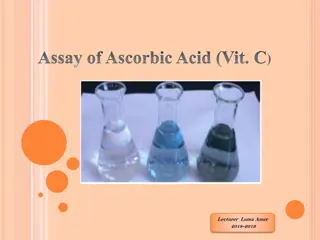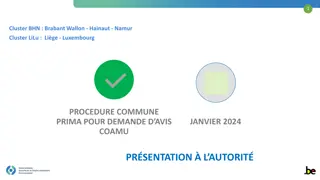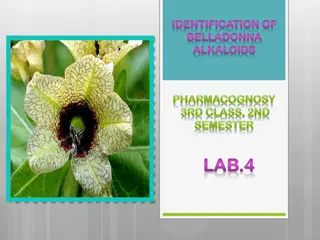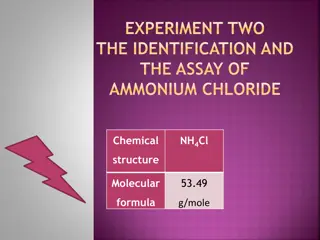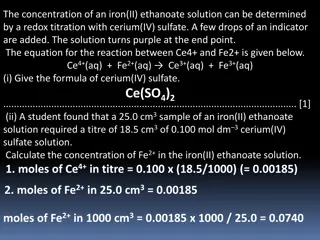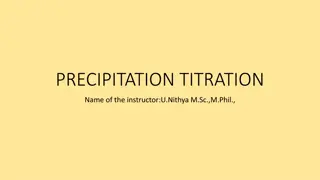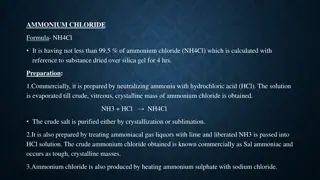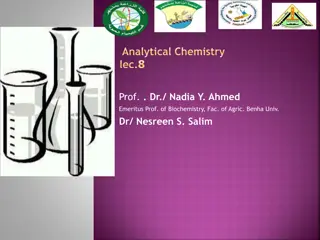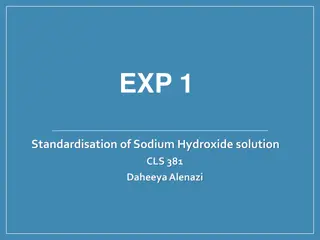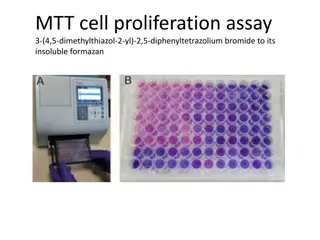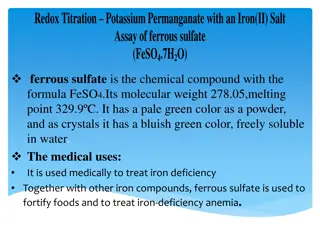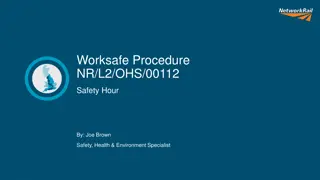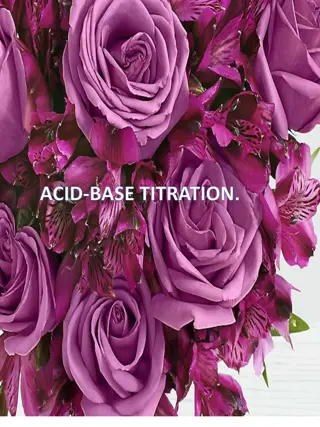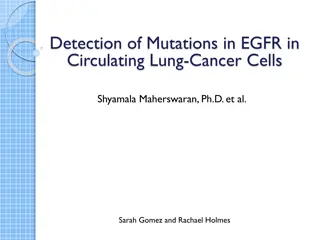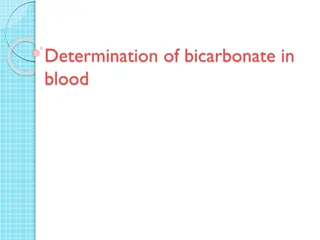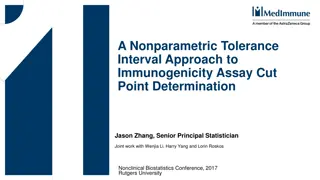TPHA Titration Tips and Assay Procedure
This content provides detailed instructions for conducting TPHA titration and assay procedures, including sample dilution, test preparations, incubation times, and control procedures. It also outlines the titration scheme for positive control and patient serum, ensuring accurate testing results.
Download Presentation

Please find below an Image/Link to download the presentation.
The content on the website is provided AS IS for your information and personal use only. It may not be sold, licensed, or shared on other websites without obtaining consent from the author.If you encounter any issues during the download, it is possible that the publisher has removed the file from their server.
You are allowed to download the files provided on this website for personal or commercial use, subject to the condition that they are used lawfully. All files are the property of their respective owners.
The content on the website is provided AS IS for your information and personal use only. It may not be sold, licensed, or shared on other websites without obtaining consent from the author.
E N D
Presentation Transcript
TPHA Titration Tips NEWBIO
Assay Procedure 1. Sample Dilution (to 1 in 20) 2. Test Add 190 L of sample diluent to the first well. Add 25 L of Positive Control or Negative Control to designated test wells. Add 10 L of sample to the same well. Transfer 25 L of diluted sample from step 1 to test well. Mix thoroughly. Note: Kit controls are pre-diluted (i.e., diluted 1 in 20) Transfer 25 L of diluted sample from step 1 to control well. Re-suspend the Test and Control Cells thoroughly. Add 75 L of Test Cells to test well, and 75 L Control Cells to the control well. (Final sample dilution is 1 in 80) Mix wells thoroughly. Incubate at 15-30 C on a vibration-free surface for 45 - 60 minutes. Read the agglutination patterns. Patterns are stable if undisturbed
Sample Titration Procedure 9 wells are needed for each sample. 3. Test 1. Sample Dilution (to 1 in 20) Re-suspend the Test Cells thoroughly Add 75 L of Test Cells to each well. Add 190 L of sample diluent to a well. Add 10 L of sample to the same well. (Final sample dilution is 1 in 80 1 in 10,240) Mix thoroughly. Mix wells thoroughly. Note: Kit controls are pre-diluted (i.e., diluted 1 in 20) Incubate at 15-30 C on a vibration-free surface for 45 - 60 minutes. 2. Titration Read the agglutination patterns. Patterns are stable if undisturbed. Leave the first well empty, add 25 L of diluent all other wells in the sequence. Transfer 25 L from step 1 to the first well. The titre of the sample is the reciprocal of the final positive sample dilution. Transfer 25 L from step 1 to the second well and mix, then serially dilute along the well sequence, discard the excess 25 L from the final well. Note: Care must be taken to avoid carryover of sample between serial dilution steps
Control Procedure The Positive and Negative Controls must be run with each assay. Additional QC testing may be performed by the operator by the inclusion of other characterised specimens or reference material. The Positive Control should produce a positive result and the Negative Control should produce a negative result with the test. When the Kit Positive is titrated, the expected end point is 1/640 1/2560. If the appropriate results are not obtained with the controls, the assay is considered invalid and all samples within that assay should be retested. TPHA Controls are pre-diluted. They should be added directly to the reaction well without being diluted in TPHA Sample Diluent. Test Cells are added directly to the Controls.
Titration Scheme for Positive Control Tube # 1 2 3 4 5 6 7 8 9 Diluent 25 L 25 L 25 L 25 L 25 L 25 L Pos Control 1:20 (pre- diluted 25 L 25 L 25 L 25 L 25 L 25 L 25 L 25 L Tube # 1 2 3 4 5 6 7 8 9 Serum Dilution 1:20 1:20 1:40 1:80 1:160 1:320 1:640 1:1280 Control Cells 75 L Test Cells 75 L 75 L 75 L 75 L 75 L 75 L 75 L Final Dilution 1:80 1:80 1:160 1:320 1:640 1:1280 1:2560 1:5120
Titration Scheme for Patient Serum Tube # 1 2 3 4 5 6 7 8 9 Diluent 190 L 25 L 25 L 25 L 25 L 25 L 25 L Patient serum/plasma 10 L 25 L 25 L 25 L 25 L 25 L 25 L Tube # 1 2 3 4 5 6 7 8 9 Serum Dilution 1:20 1:20 1:20 1:40 1:80 1:160 1:320 1:640 1:1280 Control Cells 75 L Test Cells 75 L 75 L 75 L 75 L 75 L 75 L 75 L Final Dilution 1:80 1:80 1:160 1:320 1:640 1:1280 1:2560 1:5120
Interpretation of Results A sample where the Test Cell well is non-reactive should be considered as negative for T.pallidum antibodies. Reactivity less than equivocal is considered negative. A sample where the Test Cell well is reactive or equivocal indicates antibodies to T.pallidum resulting from a syphilis infection. The sample should be repeated in duplicate. Where either repeat duplicate result is reactive or equivocal the sample should be considered as positive for T.pallidum antibodies. Where both duplicate repeat results are non-reactive then the samples is determined as non-reactive. Where a sample is reactive in both Test and Control Cells, if the agglutination is greater in the Test Cells then the sample is considered positive and should be repeated as above. When running the sample titration procedure, a titre of 1/80 is considered reactive and the sample should be repeated in duplicate. Reactive results may indicate active, past or successfully treated syphilis infections
Interpretation Guide * Scored as N as they lack the characteristic soft edges of a
Further Reading WWW.NEWBIO.COM
